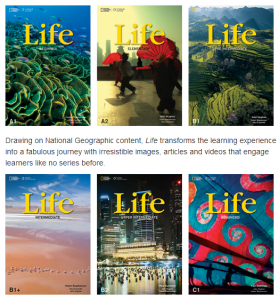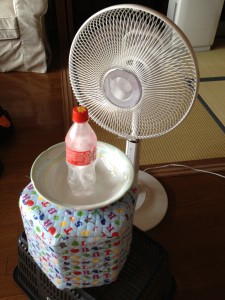language courses materials Review reviews textbooks
by sendaiben
leave a comment
Review: Life (4-skills series by Cengage)
After a long hiatus, a review. This textbook is for teenagers and adults.
Life is a 6-level, 4-skills series consisting of a student book, workbook, and teacher’s book at each level. The student book has a DVD with videos, and the teacher’s book contains two CDs with the class audio. The workbook also has a CD for listening-based homework. The series runs from Beginner (A1) to Advanced (C1).
First impression: Life is gorgeous. Cengage is really leveraging all those National Geographic photos they have access to, and it is working really well. If you are a Japan-based teacher you will probably be struck by how dense the book is -there is a lot on each page and much less white space than we are used to. Someone described it as a ‘European-style’ textbook, as opposed to ‘Asian-style’.
The Good
- This is a very attractive textbook. The design and production values are very high.
- There is a lot of content. Each book has 12 units, each unit has 6 sections. We’ve been working through one section per class so far.
- A really nice variety of topics and media (print. audio, video).
- There is a lot of variety. Reading, grammar, vocabulary, and speaking exercises on almost every page.
- The class audio is included in the teacher book. I like this idea a lot, rather than making us buy separate overpriced classroom CDs like many publishers do.
- The website actually seems to have useful materials on it 🙂
The Bad
- It’s expensive. All those production values come at a cost (EDIT: but there is a split edition I haven’t seen that incorporates half of the student book and workbook together).
- For Japanese students, it’s completely unbalanced. The grammar parts are way too easy, the reading/listening are too difficult.
- The dense page layouts can be intimidating (just a first impression problem).
Overall
I really like the series so far. We’re three weeks in and the students like it and are challenged by it, and it’s a fairly intuitive textbook from the teacher’s point of view. We’ve been using the Intermediate level with our ‘advanced’ high school student eikaiwa class, so I’m looking forward to using some of the other levels in due course. Recommended.
curriculum expectations language courses materials presentations publishing textbooks university
by sendaiben
leave a comment
Creating new teaching material
This semester I am working on a new presentation textbook for my classes here at Tohoku University (okay, so I am also hoping I will be able to sell it to a publisher eventually too), and thought it might be interesting to write a little about how that is turning out. Experienced material developers probably won’t get much out of this, but if you are just starting out like I am, or have yet to start, you might find something useful.
My desk at work. Note the all-important coffee cup and blank notebook -I find it really helpful to explore ideas on paper before starting work on the computer.
For my presentation course, I was provided with some fairly rigid constraints: too many students (one class of 32 and one of 25), too few classes (maximum of 14, more like 13 once the first one is used up for orientation), and a not-quite perfect classroom (it’s a little too small for group work). However, this is actually helpful, as it provides space in which to work. Having complete free reign paralyses me.
My project is very much a work in progress at the moment, but here are the major steps so far:
- determine the goals of the course
- decide on topics to include, and the order to teach them in
- establish a class routine
- figure out what materials to create for each class
- write the materials
- scribble over the materials in red pen after class with corrections and ideas
I have realised those four elements in bold are the foundation of a class, and getting them straight is probably 90% of the work. Now that they are done, and in great contrast to previous courses I have designed, it’s pretty easy to sit down each week and plan my classes.
Right now I am mainly trying to get the content and the activities right, and not worrying too much about design.
Has anyone successfully completed a project like this? Am I missing anything?
business Kindle materials online resources personal publishing
by sendaiben
4 comments
Self-publishing on Kindle
Last weekend I did something I have been meaning to do for a long time: I sat down and wrote a short book, edited and formatted it, and published it on Kindle through Amazon.
It really was that easy.
The process is extremely clear and Amazon has several tutorials to walk you through how to sign up, format your work, and upload it to the site. Once you have finished they check it (takes 12-48 hours) and then it goes live and people rush to buy it… or not, in my case 🙂
The book(let) is called Air Miles and Hotel Points in Japan, and it’s available free in any Amazon Kindle store worldwide for the next 24 hours or so. Please check it out if you are interested, and if you are feeling particularly generous you could leave an honest review.
The thing is, if you have been sitting on an idea for a novel or a non-fiction book, why not go ahead and put it out there? I’ll be happy to help if you have any questions.
life in Japan living in Japan materials personal technology
by sendaiben
2 comments
Summer tip: use a fan and ice instead of air conditioning
This post is dedicated to my friend Philip, ’cause he needs it right now 😉
This summer has been fairly mild in Sendai, but the last couple of weeks have been hotter. I don’t like air conditioning and prefer to use a combination of other strategies to stay cool outside of work. At home I wear as little as possible, sleep on bamboo sheets (one of the greatest inventions ever), and use an electric fan.
One way to make an electric fan more effective is to combine it with ice. This has two benefits: it takes some of the moisture out of the air through condensation and also lowers the temperature of the air slightly. You can see my setup in the picture above. A plastic bottle 2/3 full of water, frozen, a bowl to catch the condensation (this bottle accumulates a couple of centimeters of water in the bowl by the time it thaws out completely), and something to raise the bowl so that it is in front of the fan.
If you prepare three or four bottles you can rotate them fairly constantly and maintain a more pleasant environment without the expense, environmental damage, and air quality degradation of air conditioning.
Any other tips for the summer?
blogging expectations Language learning materials online resources personal self-study
by sendaiben
2 comments
The daily practice
A short comment today. The concept behind this Bill Gates quote “most people overestimate what they can do in one year and underestimate what they can do in ten years” has been on my mind recently.
I’ve also seen it in my students’ and in my own life.
As one example, I recently started studying kanji again (you’d think I’d have this by now, after thirteen years in Japan) and have resolved to use Anki for 10-30 minutes in the morning each day before doing anything else. I have mostly kept on top of this and now after a couple of months I have done over six hours of focused kanji study*.
Doesn’t sound like much, but I am noticing the effects when reading and more importantly writing in Japanese.
The point is that seemingly insignificant daily habits can have a huge payoff. What are your daily habits?
*I’m using the Core 2000 and 6000 and JALUP RTK decks to study from.




